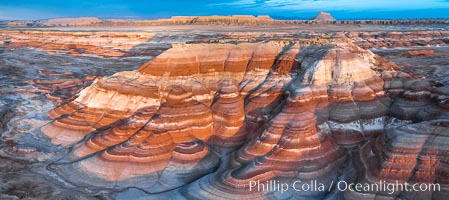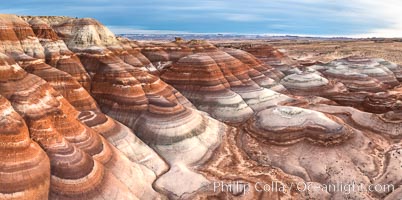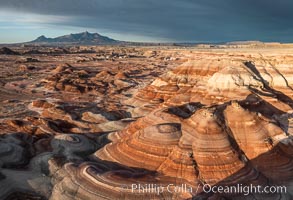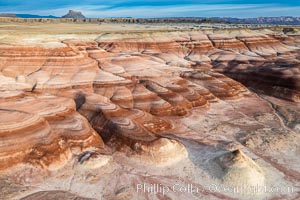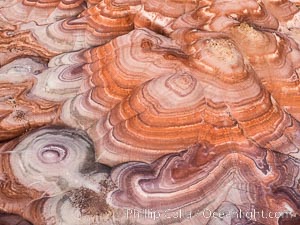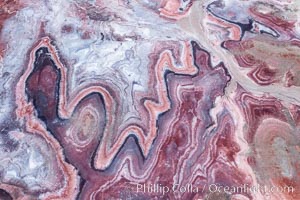
Fantastic colorful sedimentary patterns of Bentonite layers, seen as striations exposed in the Utah Badlands. The Bentonite Hills are composed of the Brushy Basin shale member of the Morrison Formation formed during Jurassic times when mud, silt, fine sand, and volcanic ash were deposited in swamps and lakes into layers, now revealed through erosion. Aerial photograph.
Location: Utah
Image ID: 38053
Location: Utah
Image ID: 38053
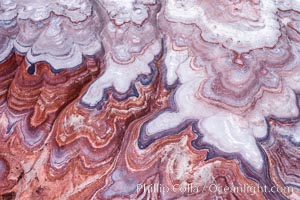
Fantastic colorful sedimentary patterns of Bentonite layers, seen as striations exposed in the Utah Badlands. The Bentonite Hills are composed of the Brushy Basin shale member of the Morrison Formation formed during Jurassic times when mud, silt, fine sand, and volcanic ash were deposited in swamps and lakes into layers, now revealed through erosion. Aerial photograph.
Location: Utah
Image ID: 38056
Location: Utah
Image ID: 38056
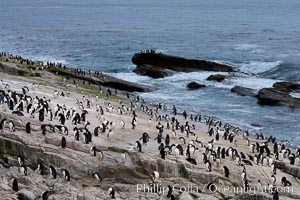
Rockhopper penguins, on rocky coastline of New Island in the Falklands. True to their name, rockhopper penguins scramble over the rocky intertidal zone and up steep hillsides to reach their nesting colonies which may be hundreds of feet above the ocean, often jumping up and over rocks larger than themselves. Rockhopper penguins reach 23" and 7.5lb in size, and can live 20-30 years. They feed primarily on feed on krill, squid, octopus, lantern fish, molluscs, plankton, cuttlefish, and crustaceans.
Species: Rockhopper penguin, Western rockhopper penguin, Eudyptes chrysocome, Eudyptes chrysocome chrysocome
Location: New Island, Falkland Islands, United Kingdom
Image ID: 23744
Species: Rockhopper penguin, Western rockhopper penguin, Eudyptes chrysocome, Eudyptes chrysocome chrysocome
Location: New Island, Falkland Islands, United Kingdom
Image ID: 23744
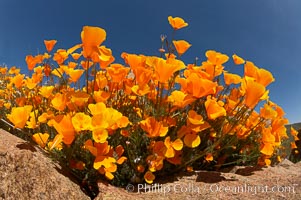
California poppies cover the hills in a brilliant springtime bloom.
Species: California poppy, Eschscholtzia californica, Eschscholzia californica
Location: Elsinore, California
Image ID: 20491
Species: California poppy, Eschscholtzia californica, Eschscholzia californica
Location: Elsinore, California
Image ID: 20491
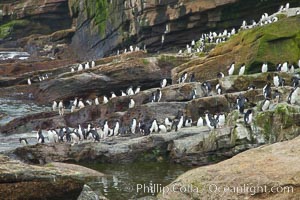
Rockhopper penguins, on rocky coastline of New Island in the Falklands. True to their name, rockhopper penguins scramble over the rocky intertidal zone and up steep hillsides to reach their nesting colonies which may be hundreds of feet above the ocean, often jumping up and over rocks larger than themselves. Rockhopper penguins reach 23" and 7.5lb in size, and can live 20-30 years. They feed primarily on feed on krill, squid, octopus, lantern fish, molluscs, plankton, cuttlefish, and crustaceans.
Species: Rockhopper penguin, Western rockhopper penguin, Eudyptes chrysocome, Eudyptes chrysocome chrysocome
Location: New Island, Falkland Islands, United Kingdom
Image ID: 23742
Species: Rockhopper penguin, Western rockhopper penguin, Eudyptes chrysocome, Eudyptes chrysocome chrysocome
Location: New Island, Falkland Islands, United Kingdom
Image ID: 23742
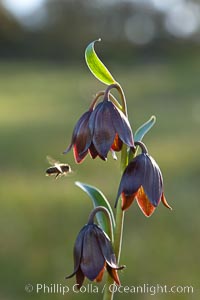
Chocolate lily growing among grasses on oak-covered hillsides. The chocolate lily is a herbaceous perennial monocot that is increasingly difficult to find in the wild due to habitat loss. The flower is a striking brown color akin to the color of chocolate.
Species: Chocolate lily, Fritillaria biflora
Location: Santa Rosa Plateau Ecological Reserve, Murrieta, California
Image ID: 24366
Species: Chocolate lily, Fritillaria biflora
Location: Santa Rosa Plateau Ecological Reserve, Murrieta, California
Image ID: 24366
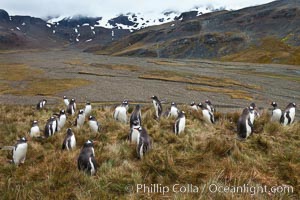
Gentoo penguins, permanent nesting colony in grassy hills about a mile inland from the ocean, near Stromness Bay, South Georgia Island.
Species: Gentoo penguin, Pygoscelis papua
Location: Stromness Harbour, South Georgia Island
Image ID: 24586
Species: Gentoo penguin, Pygoscelis papua
Location: Stromness Harbour, South Georgia Island
Image ID: 24586
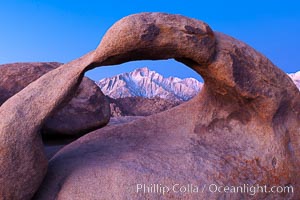
Mobius Arch at sunrise, framing snow dusted Lone Pine Peak and the Sierra Nevada Range in the background. Also known as Galen's Arch, Mobius Arch is found in the Alabama Hills Recreational Area near Lone Pine.
Location: Alabama Hills Recreational Area, California
Image ID: 27622
Location: Alabama Hills Recreational Area, California
Image ID: 27622
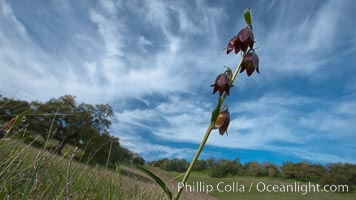
Chocolate lily growing among grasses on oak-covered hillsides. The chocolate lily is a herbaceous perennial monocot that is increasingly difficult to find in the wild due to habitat loss. The flower is a striking brown color akin to the color of chocolate.
Species: Chocolate lily, Fritillaria biflora
Location: Santa Rosa Plateau Ecological Reserve, Murrieta, California
Image ID: 24369
Species: Chocolate lily, Fritillaria biflora
Location: Santa Rosa Plateau Ecological Reserve, Murrieta, California
Image ID: 24369
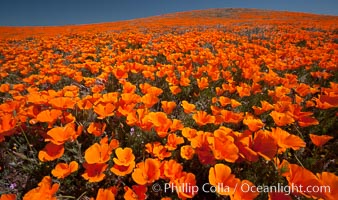
California poppies, hillside of brilliant orange color, Lancaster, CA.
Species: California poppy, Eschscholtzia californica, Eschscholzia californica
Location: Antelope Valley California Poppy Reserve SNR, Lancaster
Image ID: 25224
Species: California poppy, Eschscholtzia californica, Eschscholzia californica
Location: Antelope Valley California Poppy Reserve SNR, Lancaster
Image ID: 25224
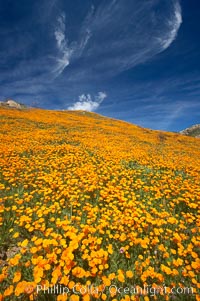
California poppies cover the hillsides in bright orange, just months after the area was devastated by wildfires.
Species: California poppy, Eschscholtzia californica, Eschscholzia californica
Location: Del Dios, San Diego, California
Image ID: 20492
Species: California poppy, Eschscholtzia californica, Eschscholzia californica
Location: Del Dios, San Diego, California
Image ID: 20492
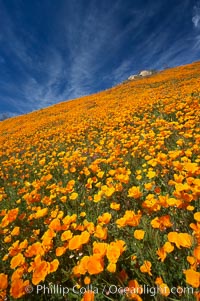
California poppies cover the hillsides in bright orange, just months after the area was devastated by wildfires.
Species: California poppy, Eschscholtzia californica, Eschscholzia californica
Location: Del Dios, San Diego, California
Image ID: 20499
Species: California poppy, Eschscholtzia californica, Eschscholzia californica
Location: Del Dios, San Diego, California
Image ID: 20499
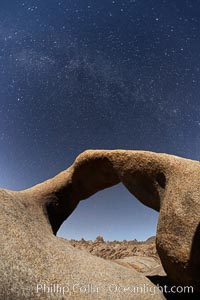
Mobius Arch with the Milky Way galaxy appearing in the night sky above.
Location: Alabama Hills Recreational Area, California
Image ID: 21737
Location: Alabama Hills Recreational Area, California
Image ID: 21737
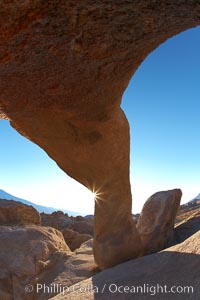
Mobius Arch in golden early morning light. The natural stone arch is found in the scenic Alabama Hlls near Lone Pine, California.
Location: Alabama Hills Recreational Area, California
Image ID: 21738
Location: Alabama Hills Recreational Area, California
Image ID: 21738
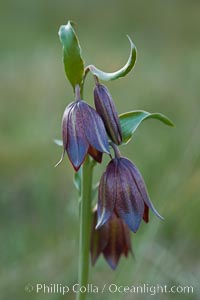
Chocolate lily growing among grasses on oak-covered hillsides. The chocolate lily is a herbaceous perennial monocot that is increasingly difficult to find in the wild due to habitat loss. The flower is a striking brown color akin to the color of chocolate.
Species: Chocolate lily, Fritillaria biflora
Location: Santa Rosa Plateau Ecological Reserve, Murrieta, California
Image ID: 24367
Species: Chocolate lily, Fritillaria biflora
Location: Santa Rosa Plateau Ecological Reserve, Murrieta, California
Image ID: 24367
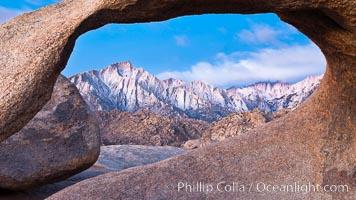
Mobius Arch at sunrise, framing snow dusted Lone Pine Peak and the Sierra Nevada Range in the background. Also known as Galen's Arch, Mobius Arch is found in the Alabama Hills Recreational Area near Lone Pine.
Location: Alabama Hills Recreational Area, California
Image ID: 27646
Location: Alabama Hills Recreational Area, California
Image ID: 27646
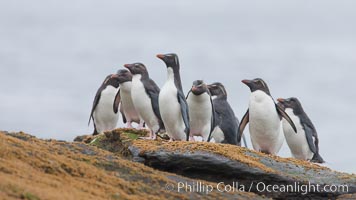
Rockhopper penguins, on rocky coastline of New Island in the Falklands. True to their name, rockhopper penguins scramble over the rocky intertidal zone and up steep hillsides to reach their nesting colonies which may be hundreds of feet above the ocean, often jumping up and over rocks larger than themselves. Rockhopper penguins reach 23" and 7.5lb in size, and can live 20-30 years. They feed primarily on feed on krill, squid, octopus, lantern fish, molluscs, plankton, cuttlefish, and crustaceans.
Species: Rockhopper penguin, Western rockhopper penguin, Eudyptes chrysocome, Eudyptes chrysocome chrysocome
Location: New Island, Falkland Islands, United Kingdom
Image ID: 23747
Species: Rockhopper penguin, Western rockhopper penguin, Eudyptes chrysocome, Eudyptes chrysocome chrysocome
Location: New Island, Falkland Islands, United Kingdom
Image ID: 23747
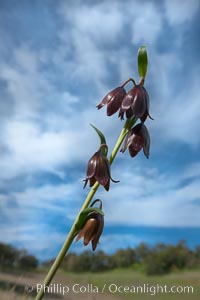
Chocolate lily growing among grasses on oak-covered hillsides. The chocolate lily is a herbaceous perennial monocot that is increasingly difficult to find in the wild due to habitat loss. The flower is a striking brown color akin to the color of chocolate.
Species: Chocolate lily, Fritillaria biflora
Location: Santa Rosa Plateau Ecological Reserve, Murrieta, California
Image ID: 24372
Species: Chocolate lily, Fritillaria biflora
Location: Santa Rosa Plateau Ecological Reserve, Murrieta, California
Image ID: 24372
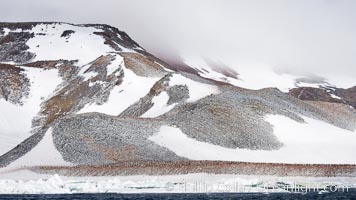
Enormous colony of Adelie penguins covers the hillsides of Paulet Island.
Species: Adelie penguin, Pygoscelis adeliae
Location: Paulet Island, Antarctic Peninsula, Antarctica
Image ID: 24836
Species: Adelie penguin, Pygoscelis adeliae
Location: Paulet Island, Antarctic Peninsula, Antarctica
Image ID: 24836
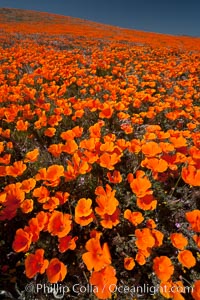
California poppies, hillside of brilliant orange color, Lancaster, CA.
Species: California poppy, Eschscholtzia californica, Eschscholzia californica
Location: Antelope Valley California Poppy Reserve SNR, Lancaster
Image ID: 25228
Species: California poppy, Eschscholtzia californica, Eschscholzia californica
Location: Antelope Valley California Poppy Reserve SNR, Lancaster
Image ID: 25228
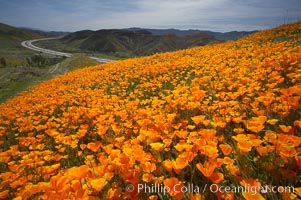
California poppies cover the hills in a brilliant springtime bloom. Interstate 15 I-15 is seen in the distance.
Species: California poppy, Eschscholtzia californica, Eschscholzia californica
Location: Elsinore, California
Image ID: 20494
Species: California poppy, Eschscholtzia californica, Eschscholzia californica
Location: Elsinore, California
Image ID: 20494
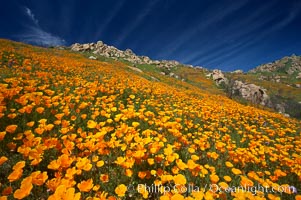
California poppies cover the hillsides in bright orange, just months after the area was devastated by wildfires.
Species: California poppy, Eschscholtzia californica, Eschscholzia californica
Location: Del Dios, San Diego, California
Image ID: 20497
Species: California poppy, Eschscholtzia californica, Eschscholzia californica
Location: Del Dios, San Diego, California
Image ID: 20497
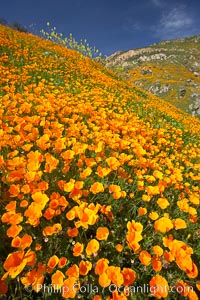
California poppies cover the hillsides in bright orange, just months after the area was devastated by wildfires.
Species: California poppy, Eschscholtzia californica, Eschscholzia californica
Location: Del Dios, San Diego, California
Image ID: 20511
Species: California poppy, Eschscholtzia californica, Eschscholzia californica
Location: Del Dios, San Diego, California
Image ID: 20511
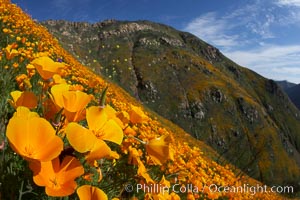
California poppies cover the hillsides in bright orange, just months after the area was devastated by wildfires.
Species: California poppy, Eschscholtzia californica, Eschscholzia californica
Location: Del Dios, San Diego, California
Image ID: 20540
Species: California poppy, Eschscholtzia californica, Eschscholzia californica
Location: Del Dios, San Diego, California
Image ID: 20540
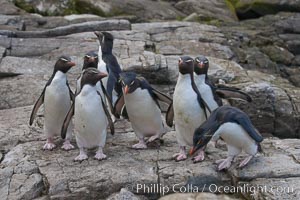
Rockhopper penguins, on rocky coastline of New Island in the Falklands. True to their name, rockhopper penguins scramble over the rocky intertidal zone and up steep hillsides to reach their nesting colonies which may be hundreds of feet above the ocean, often jumping up and over rocks larger than themselves. Rockhopper penguins reach 23" and 7.5lb in size, and can live 20-30 years. They feed primarily on feed on krill, squid, octopus, lantern fish, molluscs, plankton, cuttlefish, and crustaceans.
Species: Rockhopper penguin, Western rockhopper penguin, Eudyptes chrysocome, Eudyptes chrysocome chrysocome
Location: New Island, Falkland Islands, United Kingdom
Image ID: 23741
Species: Rockhopper penguin, Western rockhopper penguin, Eudyptes chrysocome, Eudyptes chrysocome chrysocome
Location: New Island, Falkland Islands, United Kingdom
Image ID: 23741
